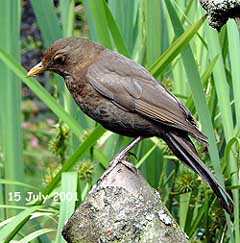Go to last entry....................................Go to previous entry
This plant's flowers have been on the verge of opening completely for about five days. Most of the flowers still have their petals rolled up like spikes around the flower head. This is the plant that the small fly was pictured on as its laid its eggs on 26 June. Similar flies have been present every day. In fact it seems very popular with a lot of insects. The flower head pictured stands about 130cm above the ground. While it is certainly a Ragwort plant I am confused by the leaves which are much more convoluted that any in the Ragwort illustrations I have available. On the bird front, things have been quite quiet over the last few hot days. Our House Sparrow flock empties the feeder every day, with the Collared Doves and Wood Pidgeons cleaning up spillages. The Greenfinches polish off the sunflower seeds and the Blue tits visit the feeder for mealworms, and enjoy the peanuts. The Robin comes a couple of times during the day, although I am not seeing the juvenile at the moment. Our blackbird with the damaged wing is appearing a lot less - I checked her last nest and found one piece of broken shell in it. The 'intruder' female must have got chicks now as she is frequently collecting food, including mealworms as she becomes more confident.
This little creature came to my attention this afternoon when I thought something was biting my leg. With a body 3mm long and antennae 2.5mm long it has no wings and runs around very quickly. An e-mail from Susan and Steve in Liverpool has identified it as the nymph of Heterotoma meriopterum, a grass bug.
A sight to bring tears to the eyes of many gardeners is the farming of aphids by the ants. Here a 'new' herd of Black Bean Aphids is being organised on the back of an Iris leaf.
The presence of the Aphids means that the ladybirds have a good supply of food for themselves and their offspring. Here are two more seen today. The one on the left is another Two-spot variant. The right hand image is of a variant of a 14-spot ladybird (Propylea 14-punctuata). Its base colour was very pale, hardly the yellow of my book illustrations.
This bug was spotted on one of the tall grasses by the pond. Unfortunately, it would not co-operate and present a dorsal view for me to photograph, insisting on moving to the other side of the flower head each time I tried to photograph it. I think it is a Common Green Capsid (Lygocoris pabulinus) Two bird notes to add - We had a Sparrowhawk visit yesterday with one sparrow carried away. The intruder female Blackbird is now becoming dominant and continues to feed her young (wherever they are). Our old female only makes occasional appearances. The males have become rare visitors for the moment.
In the meantime the adult male was also about. He seems to have lost his tail feathers for the moment - I wonder why?
This Brown lacewing (possibly Hemerobius humulinus) was spotted this afternoon hanging on to the frame of a shelter put up in the garden during our current very warm spell. This is another Aphid eater.
We had a fleeting glimpse of a Burnet moth flying through the garden, its red colour showing up brilliantly in the afternoon sunshine. It flew right through the flock of sparrows feeding by the hawthorn. A few of them took an interest but it went on to the next garden unharmed. We are still lacking in butterflies this summer. I have only seen one (a White) in the garden over the last week.
7 July - A solitary Sawfly larva, spotted on the Birch tree this afternoon. It may be the larva of Trichiosoma lucorum, which is not regarded as a pest. It is also found on Willow and Poplar trees. John Grearson, who has a special interest in sawflies, has suggested that it could be a member of the genus Pristiphora. He notes that it is a solitary larva, it has bold head markings, there are black marks at the base of the thorasic legs and the way the tail is 'hunched up' is also indicative of this genus.
First seen on the Birch tree, but pictured later on the Bamboo, yet another Ladybird. It is very similar to Calvia 14-guttata in colouring although this one seems to have extra(?) spots.
Back to the long grass again for this beetle that seems to be very similar to Athous haemorrhoidalis (a Click Beetle). However, the beetle pictured did not show the usual Click beetle ability to leap into the air and right itself when it was put onto its back.
Yesterday I mentioned the changing relationship between the two Blackbird females. Today this change was emphasised when 'our' female with the damaged wing was actually actually chased away from the garden by the new female, who continues to take food for her young. I am not seeing the males at the moment. There was a Magpie family about
numerous times through the day - there seemed to be three juveniles
pestering a parent for food, much to the consternation of the
other birds in the neighbourhood.
The magnified image shows the developing wings. I assume it is a Bush Cricket although, as usual the books concentrate only on illustrations of adults.
Back on the 4th of July I was bitten by a bug nymph. Today I spotted this adult bug, possibly of the same type (Heterotoma meriopterum) under the flower head of Self-heal. If you look carefully behind the front legs you may just make out the bug's rostrum, or beak that curves back from its head.
Its body is 12mm long, with the ovipositor adding another 7mm. Not featured in the picture, its antennae add another 30mm to that length!
Our old faithful Blackbird female seems to be spending more time here again, with increasing confidence. Here she is perched on the log in the pond, trying to spot mealworms (thrown to the frogs by me earlier!). She seems to be collecting food to take away. Has she produced a new brood elsewhere, at the sixth attempt? In the meantime the intruder Blackbird pair seems to have disappeared completely, and in the last week I have only seen one visit by a Blackbird male. Bluetit visits to the feeder are becoming less frequent, with visits by single birds only. Other bird activity in the garden has been fairly quiet in terms of species seen. 'Our' House Sparrow flock often numbers 40+. Starling numbers are hard to estimate as they are always coming and going, but we sometimes have 10+ in the garden. The Collared Doves often number 5-6 and a couple of Wood Pidgeons continue to visit. Greenfinch and Chaffinch visits have dwindled to only occasional sightings at the feeder. The Magpies often overfly the garden with the juveniles still calling for attention. When they have landed in a neighbour's garden the collared doves seem to be the first to let them know that they are not welcome. There have been some very notable absences from the garden this year so far. I have not seen any Wrens - particularly disappointing after last year's episode with the robins. Nor have I seen any visits by Goldcrests, regulars in the garden for many years. Lastly the Dunnocks who have only been seen a couple of times, while in previous years they have been resident here. |
|
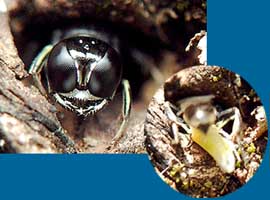 4 July -
A late start to this month's diary with an entry that could have
been put in the pond diary. Over the last couple of days I have
spotted activity on the side of the log in the middle of the
pond. Close inspection showed that mining activities were in
progress, with a small 'scree' of wood chippings forming on the
slope below. The insects responsible are bees or wasps(?). They
are not a solitary species as I have seen three enter the hole
in quick succession, taking in insect prey (see somewhat blurred
insert). This was going on at the same time as burrowing continued
inside. Last night the entrance was all but blocked by chippings
which have been cleared away this morning.
4 July -
A late start to this month's diary with an entry that could have
been put in the pond diary. Over the last couple of days I have
spotted activity on the side of the log in the middle of the
pond. Close inspection showed that mining activities were in
progress, with a small 'scree' of wood chippings forming on the
slope below. The insects responsible are bees or wasps(?). They
are not a solitary species as I have seen three enter the hole
in quick succession, taking in insect prey (see somewhat blurred
insert). This was going on at the same time as burrowing continued
inside. Last night the entrance was all but blocked by chippings
which have been cleared away this morning.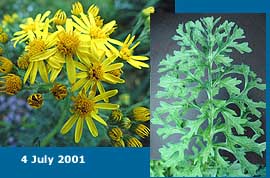
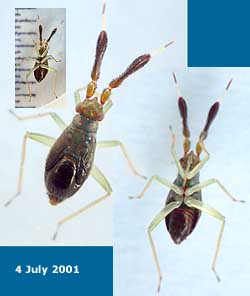
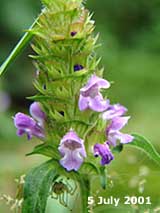 5
July - Another flower
has come into bloom in the last one or two days, a Woundwort
(possibly Marsh Woundwort) at the far side of the big pond. Its
leaves provide a hiding place for a spider, an increasingly common
sight in the garden over the last week.
5
July - Another flower
has come into bloom in the last one or two days, a Woundwort
(possibly Marsh Woundwort) at the far side of the big pond. Its
leaves provide a hiding place for a spider, an increasingly common
sight in the garden over the last week.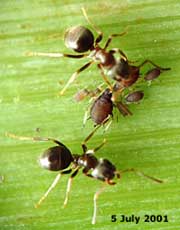
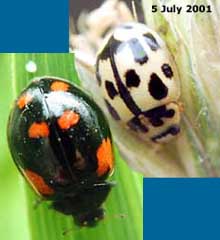
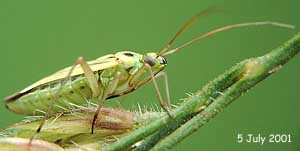
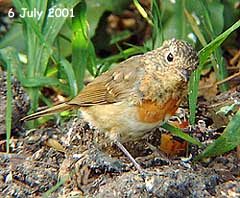 6
July - The juvenile
Robin made a couple of appearances today, giving me a chance
to get close enough to get this picture. It shows how the adult
plumage is developing 'from the bottom up'.
6
July - The juvenile
Robin made a couple of appearances today, giving me a chance
to get close enough to get this picture. It shows how the adult
plumage is developing 'from the bottom up'.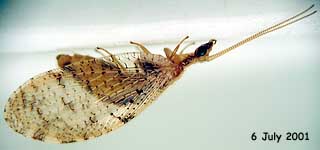
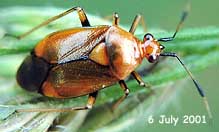 Another
bug for the diary this evening, again on the tall grass by the
pond. It is a Capsid Bug and the nearest that I can get with
its ID is Pantilius tunicatus, although the illustration
in my guide suggests a 'slimmer' body.
Another
bug for the diary this evening, again on the tall grass by the
pond. It is a Capsid Bug and the nearest that I can get with
its ID is Pantilius tunicatus, although the illustration
in my guide suggests a 'slimmer' body.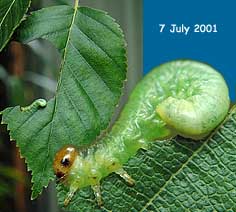
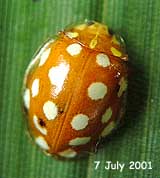
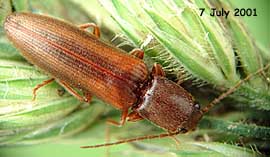
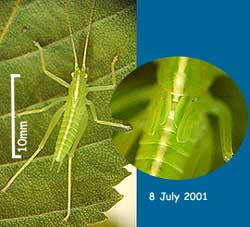 July
8 - The Birch tree yielded up another inhabitant today in
the form of this Cricket, similar to, but more developed than
one I saw on the Bamboo (20 June). It was suspended from the
underside of a leaf. There were signs of grazing nearby.
July
8 - The Birch tree yielded up another inhabitant today in
the form of this Cricket, similar to, but more developed than
one I saw on the Bamboo (20 June). It was suspended from the
underside of a leaf. There were signs of grazing nearby.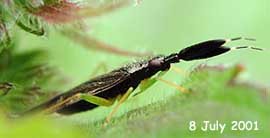
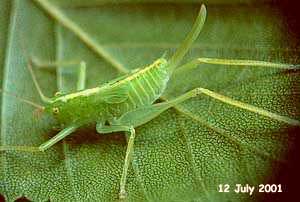 12
July - Just a short
entry today with another Bush-Cricket picture. Photographed on
a birch leaf this one has more developed wings and a well developed
ovipositor, indicating that it is a female.
12
July - Just a short
entry today with another Bush-Cricket picture. Photographed on
a birch leaf this one has more developed wings and a well developed
ovipositor, indicating that it is a female.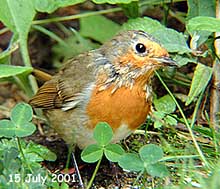 15
July - The young Robin
is shedding its juvenile coat quickly now. It has been in the
garden almost continuously this weekend. Our resident adult male
is also about and is growing new tail feathers at the moment.
I have not seen any interactions between the two so far.
15
July - The young Robin
is shedding its juvenile coat quickly now. It has been in the
garden almost continuously this weekend. Our resident adult male
is also about and is growing new tail feathers at the moment.
I have not seen any interactions between the two so far.